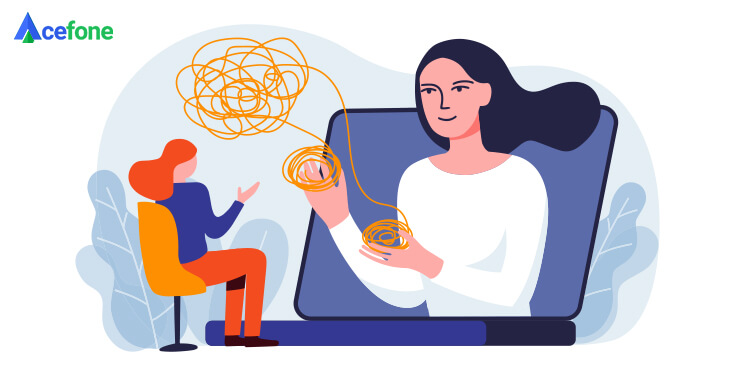This is an era of a constant digital revolution, wherein we strive to break the barriers in the way of seamless communication. And more so during this current pandemic. We have been forced to stay indoors, often deprived of meeting our near and dear ones.
Naturally, daily routines have been shattered for many. Patients who need consistent medical support are not able to access hospitals comfortably. The fear of stepping out has pushed them to look for alternatives like seeking consultation over the phone or through video conferencing.
This move has resulted in the advancement and popularity of teletherapy.
So, let’s understand this practice that’s taking the world by storm a little better.
What is teletherapy?
Teletherapy is a form of therapy that utilises technology to facilitate sessions. This involves the process of managing online appointments and other admin tasks, as well as the actual virtual patient-doctor sessions.
A few examples of teletherapy are:
- Conducting therapy sessions over the telephone
- Having group chat sessions
- Video therapy sessions for couples or individual clients
- Accepting requests for appointments through emails or messages
- Incorporating apps that can help therapists and their clients communicate with each other effectively
A study by Software Advice comparing teletherapy and in-person consultation found that 96% of clients telepsychiatry patients were happy with their online sessions.
And why is that? Video conferencing software helps improve the quality of the therapy experience for both the counsellor and the client—especially in cases that need dedicated in-person counselling.
Let’s see just how it does that. Here are the benefits of teletherapy that account for its great success in the field of telehealth:
1. Reduced waiting time
A dreaded aspect of seeking out a counselling session is the need to wake for weeks or months on end to get an audience. The thought of insurance clearance and paperwork may demotivate you from reaching out to a therapist in-person.
However, the teletherapy medium is a boon in disguise that slashes down the wait time. It eliminates the need to make repeated visits to the clinic or keep enquiring about your appointment.
With state-of-the-art communication tools in place, all you’ll need to do is to place a request remotely, and you’ll have your appointment set with minimal paperwork.
Moreover, in emergencies wherein the client is in dire need to contact a therapist, they can arrange urgent or immediate sessions using this remote medium of teletherapy.
2. Improved access to remote places
The availability of accessible medical care across the globe is extremely important. It’s integral to improving the quality of life for people everywhere. With teletherapy, you will be able to contact a reputed therapist who practises far away.
It essentially helps establish a connection between remote places and therapists who may not be accessible otherwise.
People may seek medical assistance through a video conference from the safety of their homes. This capability of teletherapy can be particularly beneficial for elderly clients who find it tough to travel and physically wait in the clinic.
3. Better privacy
Therapy may not be everyone’s cup of tea. Unfortunately, there’s still a bit of stigma attached to mental health issues. Besides, some people may have inhibitions about sharing details of their personal life with a therapist in a secure manner.
Teletherapy eliminates these issues. You may connect with the best therapist in town from the comfort of your home. With the assurance of absolute privacy, you can divulge your concerns in a free manner and have more intimate sessions.
Some people may be shy about having face-to-face conversations. For them, a simple voice call can also suffice and rather help them open up better.
4. Boosted flexibility
At times, you may not be able to visit your therapist on time. This may result in the cancellation of your session and lead to endless waiting for the next session.
This vicious cycle can be dealt with easily through remote therapies. You can easily reschedule your session if you are busy with other activities. It does not need any in-person visit but simply an online request.
Moreover, emergency meetings with the therapist can also be easily organised—without worrying about coordinating and navigating the time restraints of both parties involved.
5. Opens new opportunities for therapists
A significant advantage of teletherapy is that it does not need a physical clinic or kiosk mode to deal with clients. This offers therapists the ability to connect with patients across the globe.
They can also extend their services to benefit clients in sensitive places or to help differently-abled people. This allows for complete inclusivity and shows just how accessible mental health can be, breaking the stereotype of it being costly while still being difficult to access.
6. Provides better work-life balance for therapists
Therapists may be involved in other professional activities like having shifts in a hospital or lectures in colleges. The clinic may be functional only during a particular time in the day.
This poses a significant problem generally. If someone needs urgent counselling, they won’t know where to find the doctor and may run a wild goose chase in already difficult circumstances.
Teletherapy helps overcome this challenge. The therapist can attend to her clients without the need to be physically sought out. They can connect with clients over phone calls or a video session, right from home, or from another working environment. This kind of accessibility showcases the reliability of the therapist, resulting in happier and satisfied clients.
7. Reduces overheads to deliver therapy
Therapists spend a huge amount of money to set up their clinic. It needs to be a sizable area with the appropriate ambience and medical equipment. Moreover, clients expect the clinic to be reachable from anywhere across the city.
With teletherapy, the therapist can build the clinic without worrying about all these details. So while one would still require appropriate medical equipment, the location of the office needn’t matter, and they can work on the go whenever required.
Furthermore, teletherapy works well with home offices too. This way the therapist can reduce overhead costs and focus more on delivering better patient support.
8. Helps in streamlined communication
Every time you need to contact a therapist, you have to go through a reception, get an appointment booked, receive a confirmation. At times, you may need to make multiple calls to ask for more information—what to bring, how to approach the therapist, and so on. In our busy schedules, this could be such a hassle.
But with cloud solutions, you can improve the call flow and benefit everyone involved. For example, if you are trying to contact a therapist over an app, you will be provided with all the basic information like the medical documents you will need to bring and an approximate time frame of the session.
Moreover, you will have access to a database of frequently asked questions. This information will help you get an idea of what to expect from the session and perhaps alleviate your anxiety before the meeting.
Furthermore, chances of miscommunication are eliminated as you have a checklist of the basic requirements within reach. You can also easily reschedule or cancel your appointment without the need to contact the clinic personally.
Parting words
People are looking for newer ways to establish connections with their dear ones from the comfort of their homes. Better accessibility to medical help is no exception.
We’re currently experiencing a higher acceptance level of digital communication channels, considering the advantages of safety and convenience they’re accompanied with.
Hopefully, this post throws light on some of the various benefits of teletherapy like flexibility and better access. Undoubtedly, these merits will help pave the way for improved and reliable relationships between clients and therapists.
Learn more about cloud communication tools by visiting our resource library or simply call us on 1888-859-0450. Drop us an email at [email protected] and our team will promptly get back to you.














